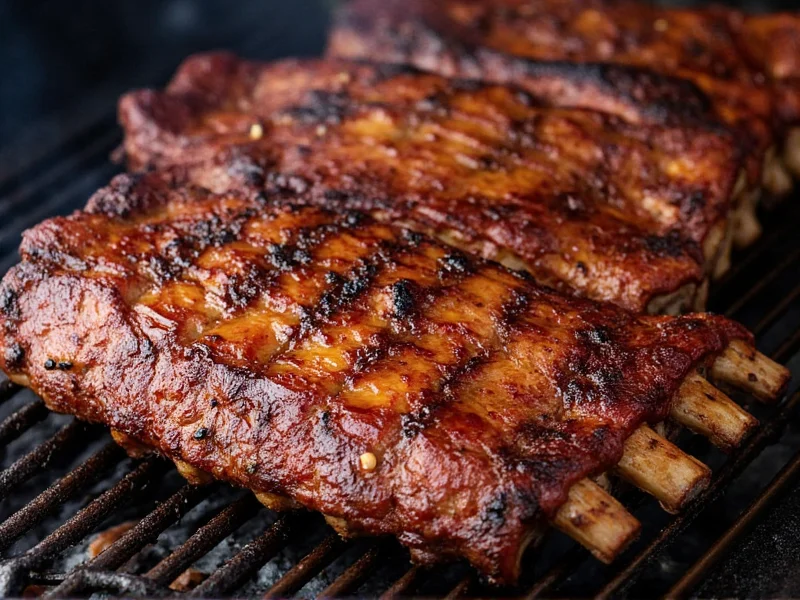The ideal internal temperature for smoked ribs is 195-205°F (90-96°C). At this range, collagen fully converts to gelatin and fat renders properly, creating tender, juicy ribs that pull back from the bone while maintaining structure.
Why Temperature Matters for Perfect Smoked Ribs
Smoking ribs isn't just about time—it's a precise science of temperature control. Many beginners make the mistake of relying solely on cooking duration rather than internal temperature, resulting in either tough, chewy ribs or ribs that fall completely off the bone. The magic happens when connective tissues break down through the Maillard reaction and collagen transforms into gelatin, which requires reaching specific temperature thresholds.
The Science Behind Ribs Temperature
Understanding the biochemical processes occurring during smoking helps explain why temperature matters more than time:
- Collagen Breakdown: This tough protein begins converting to gelatin around 160°F, but the process accelerates between 195-205°F
- Fat Rendering: Intramuscular fat melts between 130-140°F, but complete rendering happens around 190°F+
- The Stall: Evaporative cooling causes temperature to plateau around 150-170°F as moisture evaporates
- Probe Tenderness: The true indicator of doneness when a thermometer probe slides in with little resistance
Temperature Guidelines by Rib Type
| Rib Type | Recommended Internal Temp | Texture Characteristics |
|---|---|---|
| Baby Back Ribs | 195-203°F | Firm but tender, slight resistance when bitten |
| Spare Ribs | 200-205°F | More tender with noticeable pullback from bone |
| St. Louis Cut | 198-203°F | Balanced tenderness with structural integrity |
| Beef Ribs | 203-208°F | Fall-off-the-bone tenderness preferred |
Smoking Methods and Temperature Management
Different smoking approaches affect how you should monitor and interpret temperature readings:
The 3-2-1 Method Temperature Profile
This popular technique involves smoking uncovered for 3 hours, then wrapping for 2 hours, and finishing uncovered for 1 hour. During the wrapped phase, temperatures rise more quickly through the stall period. Check internal temperature during the final uncovered hour—this is when ribs typically reach the ideal 195-205°F range.
Direct Temperature Monitoring Tips
- Insert your thermometer probe into the thickest part of the meat, avoiding bone
- Check multiple sections as temperature can vary across the rack
- Use a leave-in probe thermometer for continuous monitoring
- Verify readings in multiple locations (at least 3 spots) before declaring ribs done
Common Temperature Mistakes to Avoid
Even experienced smokers make these temperature-related errors:
Stopping Too Early (Below 190°F)
Ribs cooked to only 180-185°F often remain chewy with under-rendered fat. The collagen hasn't fully converted, resulting in a rubbery texture despite appearing done.
Overcooking (Above 208°F)
While some prefer fall-off-the-bone ribs, exceeding 208°F causes muscle fibers to contract excessively, squeezing out moisture and creating dry, mushy ribs that lack structural integrity.
Misreading the Stall
Many smokers mistakenly think their cooker has failed when temperatures plateau between 150-170°F for hours. This evaporative cooling phase is normal—resist the urge to increase cooker temperature dramatically.
Doneness Indicators Beyond Temperature
While temperature provides the most reliable measurement, experienced pitmasters use these additional indicators:
- The Bend Test: When lifted with tongs, properly cooked ribs should bend easily and develop surface cracks
- Probe Test: A toothpick or thermometer probe should slide in with almost no resistance
- Meat Retraction: The bone should show 1/4 to 1/2 inch of exposed bone at the ends
- Internal Appearance: Meat should look juicy but not raw, with no pink ring beyond 1/4 inch
Resting and Serving for Optimal Results
Never skip the resting phase after reaching your target temperature. Wrap ribs in foil and let them rest for 20-30 minutes. This allows:
- Temperature equalization throughout the meat
- Residual heat to complete the cooking process
- Juices to redistribute for maximum moisture retention
- Collagen to fully set into gelatin for ideal texture
Temperature Troubleshooting Guide
Encountering issues with your smoked ribs? Check these temperature-related solutions:
Ribs Still Tough at 195°F
This typically indicates uneven cooking. Return to smoker until probe test shows tenderness, checking multiple locations. Some sections may need additional time even when others reach target temperature.
Ribs Drying Out During Final Stage
If ribs approach 205°F but seem dry, wrap immediately in butcher paper or foil with a small amount of liquid (apple juice, broth) to create a steam environment for final tenderizing.











 浙公网安备
33010002000092号
浙公网安备
33010002000092号 浙B2-20120091-4
浙B2-20120091-4